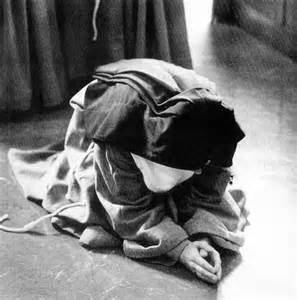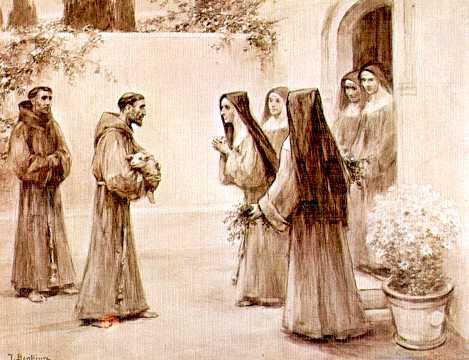 “Gaze upon Christ;
“Gaze upon Christ;
consider Christ;
contemplate Christ;
imitate Christ.”
The Story of Clare
 She had already refused several offers of marriage. At the age of 18, she was captivated by Francis’ Lenten preaching of a Christ-centred simple gospel life, and especially his emphasis on poverty as a special vocation. She had several secret meetings with him, accompanied only by a friend, Bona, and made up her mind to join him. On Palm Sunday 1212 Clare left her parents’ house secretly. She had already sold her dowry and given the money to the poor. At the little church of St Mary of the Angels, just below Assisi, she met Francis and a few of his brothers. She changed her dress for a simple habit, and took off her jewellery. Francis cut her hair, and she made a vow of obedience to him.
She had already refused several offers of marriage. At the age of 18, she was captivated by Francis’ Lenten preaching of a Christ-centred simple gospel life, and especially his emphasis on poverty as a special vocation. She had several secret meetings with him, accompanied only by a friend, Bona, and made up her mind to join him. On Palm Sunday 1212 Clare left her parents’ house secretly. She had already sold her dowry and given the money to the poor. At the little church of St Mary of the Angels, just below Assisi, she met Francis and a few of his brothers. She changed her dress for a simple habit, and took off her jewellery. Francis cut her hair, and she made a vow of obedience to him. At first she lived with a nearby Benedictine community of nuns, doing simple menial tasks.
At first she lived with a nearby Benedictine community of nuns, doing simple menial tasks. They wore no shoes, ate no meat, lived in a house that was unsatisfactory even by the standards of that era. They also kept silent most of the time. They had no beds, but slept on twigs with patched hemp for blankets. Whatever they ate was food they begged for. Clare made sure she fasted more than anyone else.
They wore no shoes, ate no meat, lived in a house that was unsatisfactory even by the standards of that era. They also kept silent most of the time. They had no beds, but slept on twigs with patched hemp for blankets. Whatever they ate was food they begged for. Clare made sure she fasted more than anyone else.  Their relationship grew more equal, and Francis would consult her on important decisions. In his last illness he came to San Damiano and Clare cared for him.
Their relationship grew more equal, and Francis would consult her on important decisions. In his last illness he came to San Damiano and Clare cared for him.The Poor Clares Today . . .
 St. Clare was the first Franciscan woman, a follower of St. Francis. Together they founded the Second Order of the Franciscan family, the Poor Clares in 1212. She lived in the church of San Damiano which St. Francis renovated for the Sisters to live in, for almost 40 years until her death.
St. Clare was the first Franciscan woman, a follower of St. Francis. Together they founded the Second Order of the Franciscan family, the Poor Clares in 1212. She lived in the church of San Damiano which St. Francis renovated for the Sisters to live in, for almost 40 years until her death.
To the foundation of Franciscan poverty and simplicity of life, Clare added the contemplative vision, bringing a unique gift to the Church. The combination of evangelical poverty and simple, Gospel living, with the silence and solitude of contemplative life within enclosed community, is Clare’s legacy to her sisters and the Church.
 Clare’s first Rule was modified by the Pope, but she remained true to the vision God gave her and, on her deathbed, secured for the Order the “privilege of highest poverty.” Thus, her desire was affirmed to depend totally on God’s providence and live the Gospel wholeheartedly.
Clare’s first Rule was modified by the Pope, but she remained true to the vision God gave her and, on her deathbed, secured for the Order the “privilege of highest poverty.” Thus, her desire was affirmed to depend totally on God’s providence and live the Gospel wholeheartedly.
Today, the Poor Clares form a worldwide Order of more than 17,000 sisters in 900 monasteries, 42 of which are in the United States. All follow the same Rule and share the same basic Constitutions. Yet each monastery remains totally autonomous, with its own abbess, chapter of professed sisters, and novitiate. Each community gives expression to its own particular nuancing of Clare’s spirit. In this way the Order’s “form of life” can be as wide as the world and as unique as each particular monastery.
From the oldest monastery in Assisi to the latest foundation in the world, the central elements of the Poor Clare life remain the same.
Each monastic day provides the opportunity for long periods of personal prayer, as well as the enrichment of Eucharistic celebration and its continuation through the Liturgy of the Hours.  Silence and solitude, so necessary to contemplative life, are balanced by close community living and the warm support of sisters who truly love each other. Simple manual work is another staple of the life, contributing toward the material support of the sisters and giving expression to their desire to serve others. Since theirs is a purely contemplative call, the sisters do not directly engage in any apostolate outside of the monastery.
Silence and solitude, so necessary to contemplative life, are balanced by close community living and the warm support of sisters who truly love each other. Simple manual work is another staple of the life, contributing toward the material support of the sisters and giving expression to their desire to serve others. Since theirs is a purely contemplative call, the sisters do not directly engage in any apostolate outside of the monastery.
Following Vatican II, the ideals of Poor Clare living have been renewed and the Order’s Constitutions have been updated. Within the approved constitutional framework each Chapter makes decisions about particular expressions of enclosure, contact with those outside of the monastery, types of work and daily schedules. Such adaptations are accidental differences; the Poor Clare spirit of evangelical poverty, prayer and contemplation remains essentially the same.
Branches of the Poor Clare Family
Over the 800 years since St. Clare and St. Francis founded the Poor Clares, there have been times when both the friars and the Poor Clares needed reform. There have been courageous women and men who responded to that call by challenging the status quo and/or beginning new branches of the family. Thus, the friars today are: Friars Minor(OFM), Conventual Friars (OFM Conv), Capuchin Friars (OFM Cap) and Third Order Regular Friars (TOR).
Likewise, today there are a variety of Poor Clare expressions; besides the OSC, there are Colettine Poor Clares (PCC), Capuchin Poor Clares (OSC Cap) and Poor Clares of Perpetual Adoration (PCPA). If you are interested in these other branches, we encourage you to look for more information about them on the Internet.
Capuchin Poor Clares: Four monasteries are located in Alamo, TX; Denver, CO; Pueblo, CO; Wilmington, DE
Colettine Poor Clares: Ten monasteries are located in Los Altos Hills, CA, Barhamsville, VA, Belleville, IL, Cleveland, OH, Chicago, IL, Joliet, IL, Kokomo, IN, Rockford, IL, Roswell, NM, and Santa Barbara, CA
Poor Clares of Perpetual Adoration: Six monasteries are located in Birmingham, AL, Canton, OH, Charlotte, NC, Cleveland, OH, San Antonio, TX, Tonopah, AZ and Washington, DC
For more information . . .
Poor Clare Sisters (OSC) (International)
Poor Clare Colettine Nuns (PCC)
(Cleveland, Ohio – First permanent foundation in the USA)
Capuchin Poor Clares (OSC Cap) (Federation of Our Lady of the Angels of North America)
Poor Clares of Perpetual Adoration (PCPA) (Our Lady of the Angels Monastery, Hanceville AL)
God of peace,
who in the poverty of the blessed Clare
gave us a clear light
to shine in the darkness of this world:
give us grace so to follow in her footsteps
that we may, at the last,
rejoice with her in your eternal glory;
through Jesus Christ our Lord.
Amen.
sources for this page may be found at: http://littleplantofstfrancis.blogspot.com/2013_07_24_archive.html, and http://poorclaresosc.org/about-poor-clare/



